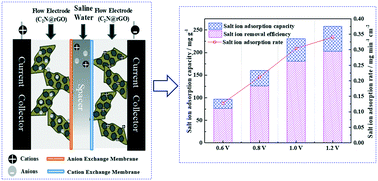Nanoarchitectured reduced graphene oxide composite C2N materials as flow electrodes to optimize desalination performance†
Abstract
Flow electrode capacitive deionization (FCDI) utilizes flowable electrodes to obtain a continuous and extensible desalination approach, eliminating the discharging step. However, the poor conductivity of flow electrode slurry and high clogging risk during the desalting process can limit desalination performance. Thus, we prepare the C2N@rGO material as a flow electrode to solve the channel blocking problem and improve the salt ion removal performance, maximizing the amount of active particles that can be added to the deionization process by forming a conductive network. The as-synthetized material possesses a large specific surface area, rich micropores, high N-doping, and tunable graphitization structure, which can further enhance the desalination properties of the as-prepared electrode. The results indicate that C2N@rGO-4% has an optimal porous structure (812.3 m2 g−1) and chemical composition (29.5%, N-doping), and the highest specific capacitance (236.6 F g−1). The FCDI results reveal that C2N@rGO-4% has a high salt ion adsorption capacity (180.72 mg g−1), salt ion adsorption rate (0.3043 mg min−1 cm2), salt ion removal efficiency (49.93%), and current efficiency (65.22%) under a 1.81 g L−1 NaCl solution at 1.0 V. Moreover, the results also indicate that the FCDI performance partly relies on the synergistic effect between the porous structure and chemical composition. Therefore, as an electrode material, C2N@rGO has strong potential for application in FCDI systems.



 Please wait while we load your content...
Please wait while we load your content...